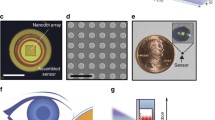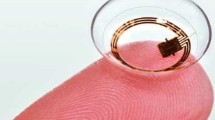Abstract
Animal models of ocular hypertension are important for glaucoma research but come with experimental costs. Available methods of intraocular pressure (IOP) elevation are not always successful, the amplitude and time course of IOP changes are unpredictable and irreversible, and IOP measurement by tonometry is laborious. Here we present a novel system for monitoring and controlling IOP without these limitations. It consists of a cannula implanted in the anterior chamber of the eye, a pressure sensor that continually measures IOP, and a bidirectional pump driven by control circuitry that can infuse or withdraw fluid to hold IOP at user-desired levels. A portable version was developed for tethered use on rats. We show that rat eyes can be cannulated for months without causing significant anatomical or physiological damage although the animal and its eyes freely move. We show that the system measures IOP with <0.7 mmHg resolution and <0.3 mmHg/month drift and can maintain IOP within a user-specified window of desired levels for any duration necessary. We conclude that the system is ready for cage- or bench-side applications. The results lay the foundation for an implantable version that would give glaucoma researchers unprecedented knowledge and control of IOP in rats and potentially larger animals.








Similar content being viewed by others
References
Abrams, L. S., S. Vitale, and H. D. Jampel. Comparison of three tonometers for measuring intraocular pressure in rabbits. Investig. Ophthalmol. Vis. Sci. 37:940–944, 1996.
Akaishi, T., N. Ishida, A. Shimazaki, H. Hara, and Y. Kuwayama. Continuous monitoring of circadian variations in intraocular pressure by telemetry system throughout a 12-week treatment with timolol maleate in rabbits. J. Ocular Pharmacol. Ther. 21:436–444, 2005.
Akula, J. D., T. L. Favazza, J. A. Mocko, I. Y. Benador, A. L. Asturias, M. S. Kleinman, R. M. Hansen, and A. B. Fulton. The anatomy of the rat eye with oxygen-induced retinopathy. Doc. Ophthalmol. 120:41–50, 2010.
Asrani, S., R. Zeimer, J. Wilensky, D. Gieser, S. Vitale, and K. Lindenmuth. Large diurnal fluctuations in intraocular pressure are an independent risk factor in patients with glaucoma. J. Glaucoma 9:134–142, 2000.
Bengtsson, B., M. C. Leske, L. Hyman, and A. Heijl. Fluctuation of intraocular pressure and glaucoma progression in the early manifest glaucoma trial. Ophthalmology 114:205–209, 2007.
Berdahl, J. P., M. P. Fautsch, S. S. Stinnett, and R. R. Allingham. Intracranial pressure in primary open angle glaucoma, normal tension glaucoma, and ocular hypertension: a case–control study. Investig. Ophthalmol. Vis. Sci. 49:5412–5418, 2008.
Chauhan, B. C., J. Pan, M. L. Archibald, T. L. LeVatte, M. E. Kelly, and F. Tremblay. Effect of intraocular pressure on optic disc topography, electroretinography, and axonal loss in a chronic pressure-induced rat model of optic nerve damage. Investig. Ophthalmol. Vis. Sci. 43:2969–2976, 2002.
Downs, J. C., C. F. Burgoyne, W. P. Seigfreid, J. F. Reynaud, N. G. Strouthidis, and V. Sallee. 24-hour IOP telemetry in the nonhuman primate: implant system performance and initial characterization of IOP at multiple timescales. Investig. Ophthalmol. Vis. Sci. 52:7365–7375, 2011.
Fitt, A. D., and G. Gonzalez. Fluid mechanics of the human eye: aqueous humour flow in the anterior chamber. Bull. Math. Biol. 68(1):53–71, 2006.
Gaasterland, D., and C. Kupfer. Experimental glaucoma in the rhesus monkey. Investig. Ophthalmol. Vis. Sci. 13:455–457, 1974.
Ha, D., W. N. de Vries, S. W. John, P. P. Irazoqui, and W. J. Chappell. Polymer-based miniature flexible capacitive pressure sensor for intraocular pressure (IOP) monitoring inside a mouse eye. Biomed. Microdevices 14:207–215, 2012.
Kee, C., T. Hong, and K. Choi. A sensitive ocular perfusion apparatus measuring outflow facility. Curr. Eye Res. 16:1198–1201, 1997.
Leonardi, M., E. M. Pitchon, A. Bertsch, P. Renaud, and A. Mermoud. Wireless contact lens sensor for intraocular pressure monitoring: assessment on enucleated pig eyes. Acta Ophthalmol. 87:433–437, 2009.
Leske, M. C., A. M. Connell, S. Y. Wu, L. G. Hyman, and A. P. Schachat. Risk factors for open-angle glaucoma: the Barbados eye studyleske. Arch. Ophthalmol. 113:918–924, 1995.
Li, R., and J. H. Liu. Telemetric monitoring of 24 h intraocular pressure in conscious and freely moving C57BL/6J and CBA/CaJ mice. Mol. Vis. 14:745–749, 2008.
Liu, J. H., X. Zhang, D. F. Kripke, and R. N. Weinreb. Twenty-four-hour intraocular pressure pattern associated with early glaucomatous changes. Investig. Ophthalmol. Vis. Sci. 44:1586–1590, 2003.
Mansouri, K., F. A. Medeiros, A. Tafreshi, and R. N. Weinreb. Continuous 24-hour monitoring of intraocular pressure patterns with a contact lens sensor: safety, tolerability, and reproducibility in patients with glaucoma. Arch. Ophthalmol. 130:1534–1539, 2012.
Mateijsen, D. J., H. J. Rosingh, H. P. Wit, and F. W. Albers. Perilymphatic pressure measurement in patients with Meniere’s disease. Eur. Arch. Otorhinolaryngol. 258:1–4, 2001.
McLaren, J. W., R. F. Brubaker, and J. S. Fitzsimon. Continuous measurement of intraocular pressure in rabbits by telemetry. Investig. Ophthalmol. Vis. Sci. 37:966–975, 1996.
McNulty, R., H. Wang, R. T. Mathias, B. J. Ortwerth, R. J. Truscott, and S. Bassnett. Regulation of tissue oxygen levels in the mammalian lens. J. Physiol. 559:883–898, 2004.
Mermoud, A., G. Baerveldt, D. S. Minckler, J. A. Prata, Jr, and N. A. Rao. Aqueous humor dynamics in rats. Graefes Arch. Clin. Exp. Ophthalmol. 234:S198–S203, 1996.
Moore, C. G., E. C. Johnson, and J. C. Morrison. Circadian rhythm of intraocular pressure in the rat. Curr. Eye Res. 15:185–191, 1996.
Morrison, J. C., C. G. Moore, L. M. Deppmeier, B. G. Gold, C. K. Meshul, and E. C. Johnson. A rat model of chronic pressure-induced optic nerve damage. Exp. Eye Res. 64:85–96, 1997.
Nusbaum, D. M., S. M. Wu, and B. J. Frankfort. Elevated intracranial pressure causes optic nerve and retinal ganglion cell degeneration in mice. Exp. Eye Res. 136:38–44, 2015.
Quigley, H. A., and E. M. Addicks. Chronic experimental glaucoma in primates. I. Production of elevated intraocular pressure by anterior chamber injection of autologous ghost red blood cells. Investig. Ophthalmol. Vis. Sci. 19:126–136, 1980.
Ren, R., J. B. Jonas, G. Tian, Y. Zhen, K. Ma, S. Li, H. Wang, B. Li, X. Zhang, and N. Wang. Cerebrospinal fluid pressure in glaucoma: a prospective study. Ophthalmology 117:259–266, 2010.
Ruiz-Ederra, J., M. García, M. Hernández, H. Urcola, E. Hernández-Barbáchano, J. Araiz, and E. Vecino. The pig eye as a novel model of glaucoma. Exp. Eye Res. 81:561–569, 2005.
Salt, A. N., and A. K. Plontke. Endolymphatic hydrops pathophysiology and experimental models. Otolaryngol. Clin. N. Am. 43:971–983, 2010.
Sappington, R. M., B. J. Carlson, S. D. Crish, and D. J. Calkins. The microbead occlusion model: a paradigm for induced ocular hypertension in rats and mice. Investig. Ophthalmol. Vis. Sci. 51:207–216, 2010.
Shareef, S. R., E. Garcia-Valenzuela, A. Salierno, J. Walsh, and S. C. Sharma. Chronic ocular hypertension following episcleral venous occlusion in rats. Exp. Eye Res. 61:379–382, 1995.
Sommer, A. Intraocular pressure and glaucoma. Am. J. Ophthalmol. 107:186–188, 1989.
Takumida, M., N. Akagi, and M. Anniko. A new animal model for Meniere’s disease. Acta Otolaryngol. 128:263–271, 2008.
Todani, A., I. Behlau, M. A. Fava, F. Cade, D. G. Cherfan, F. R. Zakka, F. A. Jakobiec, Y. Gao, C. H. Dohlman, and S. A. Melki. Intraocular pressure measurement by radio wave telemetry. Investig. Ophthalmol. Vis. Sci. 52:9573–9580, 2011.
Ueda, J., S. Sawaguchi, T. Hanyu, K. Yaoeda, T. Fukuchi, H. Abe, and H. Ozawa. Experimental glaucoma model in the rat induced by laser trabecular photocoagulation after an intracameral injection of India ink. Jpn. J. Ophthalmol. 42:337–344, 1998.
Walter, P., U. Schnakenberg, G. vom Bögel, P. Ruokonen, C. Krüger, S. Dinslage, H. C. Lüdtke Handjery, H. Richter, W. Mokwa, M. Diestelhorst, and G. K. Krieglstein. Development of a completely encapsulated intraocular pressure sensor. Ophthalmic Res. 32:278–284, 2000.
Weber, A. J., and D. Zelenak. Experimental glaucoma in the primate induced by latex microspheres. J. Neurosci. Methods 111:39–48, 2001.
Acknowledgments
The work was supported by NIH grant R21 EY023376 and a Thomas R. Lee Award from the BrightFocus Foundation. The authors thank Drs. Radouil Tzekov and Xiaolan Tang for assistance with histological processing, Dr. Wilfredo Moreno for consultations with controller design, and Dr. Curtis Margo for evaluating the pathology of implanted eyes. The authors declare the following intellectual interests: U.S. Patents 9022,968 B2 and 9314,375 B1.
Author information
Authors and Affiliations
Corresponding author
Additional information
Associate Editor Leonidas D. Iasemidis oversaw the review of this article.
Electronic supplementary material
Below is the link to the electronic supplementary material.
Supplementary material 1 (WMV 4637 kb)
Rights and permissions
About this article
Cite this article
Bello, S.A., Malavade, S. & Passaglia, C.L. Development of a Smart Pump for Monitoring and Controlling Intraocular Pressure. Ann Biomed Eng 45, 990–1002 (2017). https://doi.org/10.1007/s10439-016-1735-y
Received:
Accepted:
Published:
Issue Date:
DOI: https://doi.org/10.1007/s10439-016-1735-y




